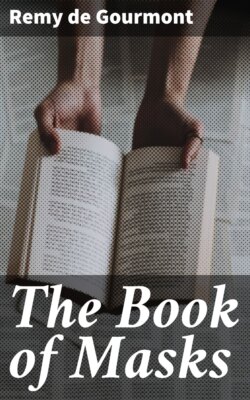Читать книгу The Book of Masks - Remy de Gourmont - Страница 6
ÉMILE VERHAEREN
ОглавлениеOf all the poets of today, narcissi along the river, Verhaeren is the least obliging in allowing himself to be admired. He is rude, violent, unskillful. Busied for twenty years in forging a strange and magical tool, he remains in a mountain cavern, hammering the reddened irons, radiant in the fire's reflection, haloed with sparks. Thus it is we should picture him, a forger who,
Comme s'il travaillait l'acier des âmes,
Martèle à grands coups pleins, les lames
Immenses de la patience et du silence.
(Tr. 3)
If we discover his dwelling and question him, he replies with a parable whose every word seems scanned on the forge, and, to conclude, he delivers a tremendous blow of his heavy hammer.
When he is not laboring at his forge, he goes forth through the fields, head and arms bare, and the Flemish fields tell him secrets they have not yet told anyone. He beholds miraculous things and is not astonished at them. Singular beings pass before him, beings whom everybody jostles without being aware, visible alone to him. He has met the November Wind:
Le vent sauvage de novembre.
Le vent,
L'avez-vous rencontré, le vent
Au carrefour des trois cents routes...?
(Tr. 4)
He has seen Death, and more than once; he has seen Fear; he has seen Silence
S'asseoir immensément du côté de la nuit.
(Tr. 5)
The characteristic word of Verhaeren's poetry is halluciné. The word leaps from page to page. An entire collection, the Campagnes hallucinées has not freed him from this obsession. Exorcism was not possible, for it is the nature and very essence of Verhaeren to be the hallucinated poet. "Sensations," Taine said, "are true hallucinations." But where does truth begin or end? Who shall dare circumscribe it? The poet, with no psychological scruples, wastes no time over troubling himself to divide hallucinations into truths or untruths. For him they are all true if they are sharp and strong, and he recounts them frankly—and when the recitation is made by Verhaeren, it is very lovely. Beauty in art is a relative result which is achieved by the mixture of very different elements, often the most unexpected. Of these elements, one alone is stable and permanent, and ought to be found in all combinations: that is novelty. A work of art must be new, and we recognize it as such quite simply by the fact that it gives a sensation not yet experienced.
If it does not give this, a work, perfect though it be adjudged, is everything that is contemptible. It is useless and ugly, since nothing is more absolutely useful than beauty. With Verhaeren, beauty is made of novelty and strength. This poet is a strong man and, since those Villes tentaculaires which surged with the violence of a telluric upheaval, no one dares to deny him the state and glory of a great poet. Perhaps he has not yet quite finished the magic instrument which for twenty years he has been forging. Perhaps he is not yet master of his language. He is unequal; he lets his most beautiful pages grow heavy with inopportune epithets, and his finest poems become entangled in what was once called prosaism. Nevertheless, the impression of power and grandeur remains, and yes: he is a great poet. Listen to this fragment from Cathédrales:
* * * * *
—O ces foules, ces foules
Et la misère et la détresse qui les foulent
Comme des houles!
Les ostensoirs, ornés de soie,
Vers les villes échafaudées,
En toits de verre et de cristal,
Du haut du choeur sacerdotal,
Tendent la croix des gothiques idées.
Ils s'imposent dans l'or des clairs dimanches
—Toussaint, Noël, Pâques et Pentecôtes blanches.
Ils s'imposent dans l'or et dans l'encens et dans la fête
Du grand orgue battant du vol de ses tempêtes
Les chapiteaux rouges et les voûtes vermeilles,
Ils sont une âme, en du soldi,
Qui vit de vieux décor et d'antique mystère
Autoritaire.
Pourtant, dès que s'éteignent le cantique
Et l'antienne naïve et prismatique,
Un deuil d'encens évaporé s'empreint
Sur les trépieds d'argent et les autels d'airain,
Et les vitraux, grands de siècles agenouillés
Devant le Christ, avec leurs papes immobiles
Et leurs martyrs et leurs héros, semblent trembler
Au bruit d'un train hautain que passe sur la ville.
(Tr. 6)
Verhaeren appears a direct son of Victor Hugo, especially in his earliest works. Even after his evolution towards a poetry more freely feverish, he still remains romantic. Here, to explain this, are four verses evoking the days of former times.
Jadis—c'était la vie errante et somnambule,
A travers les matins et les soirs fabuleux,
Quand la droite de Dieu vers les Chanaans bleus
Traçait la route d'or au fond des crépuscules.
Jadis—c'était la vie énorme, exaspérée,
Sauvagement pendue aux crins des étalons,
Soudaine, avec de grands éclairs à ses talons
Et vers l'espace immense immensément cabrée.
Jadis—c'était la vie ardent, évocatoire;
La Croix blanche de ciel, la Croix rouge d'enfer
Marchaient, à la clarté des armures de fer,
Chacune à travers sang, vers son ciel de victoire.
Jadis—c'était la vie écumante et livide,
Vécue et morte, à coups de crime et de tocsins,
Bataille entre eux, de proscripteurs et d'assassins,
Avec, au-dessus d'eux, la mort folle et splendid.
(Tr. 7)
These verses are drawn from Villages illusoires, written almost exclusively in assonant free verse, divided by means of a gasping rhythm, but Verhaeren, master of free verse, is also master of romantic verse, to which he can force, without being dashed to pieces, the unbridled, terrible gallop of his thought, drunk with images, phantoms and future visions.
